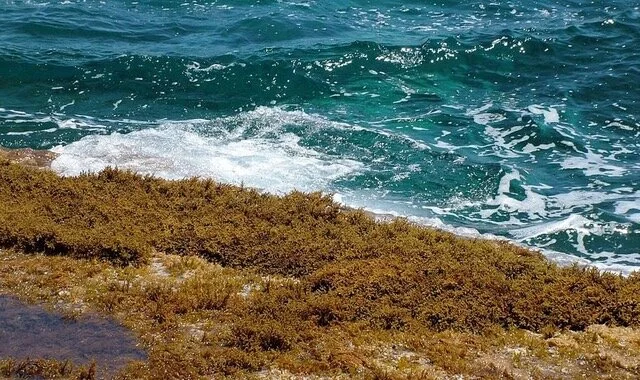Sargassum is Sacred (Vance Blackfox)
Most of my closest allies know that I make a journey to the white sand beaches of the Yucatan in Mexico every year, namely Cancun. I just love it there. Of course it is land that has been stolen by Spanish invaders from Mayan peoples, but is a land that is still very much home to Mayan people. I put down tobacco when I visit, praying for the Indigenous people that are still here, and even for the settlers who have turned a once tranquil paradise into a capitalistic, touristic destination for some of the privileged of the world, including me.
A few years ago when my bestie and I began our annual journey to the resort-ridden peninsula, we too would pose for our selfies next to the waters and run into the light surf to cool ourselves after bathing or baking in the Sun star. This summer, however, it seemed a bit of an obstacle course, both the tiptoe to the waters and entering the waters, due to the heaping helpings of seaweed that have made our favorite sand its favorite land too. The seaweed is prickly and is washed up on the beach from Merida to far south of Playa del Carmen.
How is it that in a few short years some of Mother Earth’s most beautiful beaches become blanketed with some of Mother Earth’s most healthy seaweed? This is not sarcasm. No. But it is sargassum. You’ll see what I did there in a moment.
Did you know that there is a sea in the middle of the Atlantic Ocean? Yes, that is right. There is a sea in the middle of an ocean. It is called the Sargasso Sea, and it is surrounded on all sides by the Atlantic Ocean. The Sargasso Sea is named for the sargassum seaweed that has been abundantly growing in that particular place for ages. Every year, a small portion of the sargassum would break loose from its network and be caught up in the northwesterly flowing currents and into the Caribbean Sea in the North American autumn months.
With the rise in water temperatures due to climate change, more and more sargassum is breaking away from its place, rising, and running with the current to many parts of Mexico and beyond.
Apparently, it’s gotten “so bad” according to tourists and the edifiers of tourists that the building of a wall to capture the seaweed before it makes landfall is being planned just off the coast of Playa del Carmen.
And so, what is “so bad” about seaweed?
We humans--especially those of us who are all twisted up in western european judeo christian capitalistic trance--have a very bad habit of assigning human characteristics to our non-human relatives. We do it to weather, we do it to domesticated dogs who have been mistreated or who may be remembering themselves before domestication (DNA can do that), we do it our ancestors who come back to visit us or haven’t been able to move on from this world after they die, we do it to spirit beings, we do it rock, we do it to water, and the list never ends…
This need to inappropriately or even maliciously place human characteristics on our non-human relatives is evidence of our sad separation as humans from the natural world in unhealthy and detrimental ways. And it says more about us as humans than it does about the weather, plants, rocks, animals, and water that we short change by forcing humanness on them. When instead, we could be working our way toward a greater understanding of how our non-human relatives are superior to us thinking, upright walkers with opposable thumbs.
It may be too late for most of us to regain the necessary wisdom and understanding to fully understand the unique characteristics of relatives, but it doesn’t mean that we human beings can’t try to better understand how our relatives are indeed sacred beings with wisdom in their own DNA. Each has its purpose and each is innately “so good” because the Creator created them each so.
And while we as humans aren’t always good at valuing our human relatives and relationships, just remember that our non-human relatives don’t owe you money. No, it is us who owes them.
Even the sargassum is not “so bad.” It is sacred. And once again, human greed has displaced a relative from its home. So until we can get better at being human and better relatives ourselves, we will just have to enjoy the beaches and all their sargassum.
###
Vance Blackfox (MA, Lutheran School of Theology, Chicago), a citizen of the Cherokee Nation, is guest editor of our Fall 2021 collection, “Sacred Relationship.” Learn more about that collection here. He’s also a member of the AllCreation.org contributor team. See more of Vance’s work on AllCreation here.






